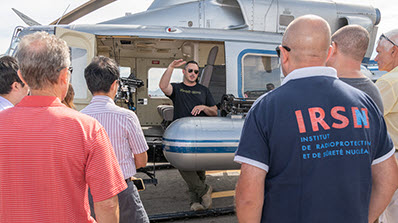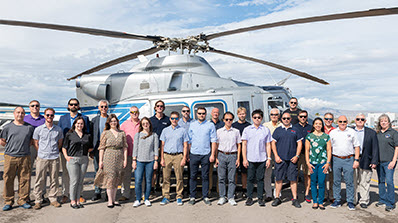Dry heat and extreme temperatures are synonymous with Las Vegas. But to Nevada National Security Site (NNSS) pilot Mike Toland, the desert temperature is more than just commentary for the local weather report or for visitors flocking to the Las Vegas Strip.
It’s critical information for NNSS Remote Sensing Laboratory pilots to consider when mapping out a mission and ensuring its success.
“Aircraft don’t like heat,” Toland said. “When it’s very hot, the air is thinner, so the engines don’t produce as much power and the rotor blades don’t have as much air to work with, which can negatively impact aircraft performance.”
Toland shared his experience flying in extreme conditions and urban environments during the 10th annual Aerial Measuring System (AMS) International Technical Exchange, recently hosted by the National Nuclear Security Administration (NNSA) Office of Nuclear Incident Policy and Cooperation and the NNSS. This year’s exchange focused on missions in complex or extreme environments.
AMS is a rapidly deployable capability that can respond to all manner of nuclear incidents and accidents in the United States and overseas. It consists of a fleet of aircraft equipped with specialized radiation detection systems to provide real-time measurements of air and ground radiation contamination. AMS scientists, technical personnel, and pilots are on-call 365 days per year / 24 hours per day to deploy in response to nuclear incidents and accidents.
Dr. Piotr Wasiolek, former longtime NNSS manager and now Aerial Measuring System International Support Lead, said the NNSS team received an overwhelming, positive response from partner countries wanting to attend the exchange in person after two years of virtual meetings. Representatives from Brazil, Canada, Germany, France, Iceland, the United Kingdom, Norway, and Taiwan attended the sessions either in-person or virtually.
AMS Technical Exchanges aim to establish strategic relationships, and encourage collaboration with international partners to strengthen U.S. and global preparedness and response. The exchanges allow an opportunity for countries to discuss radiological and nuclear terrorism threats as well as the technical tools, policies, and practical approaches to enhance capabilities when responding to those threats.
“We can find better answers to problems when we have an open, honest exchange of information with partners who are doing similar work,” said Wasiolek, an expert in aerial measuring systems. “The technical exchange provides a venue for these important discussions to take place.”
John Buckle, a representative from Natural Resources Canada, who kicked off the week with the first presentation, agreed.
“Mostly what I like is meeting all the different operators and the pilots,” said Buckle. “We get to share ideas and hopefully find solutions to common issues that we have.”
Dynamic discussions
The presentations given by all of the participants were varied and illustrated the unique situations each country encounters with extreme weather, data collection systems, and assessing the data quickly and effectively. Compared to the severe Las Vegas heat, Buckle shared that he and his team have the opposite extreme condition to prepare for – extreme cold and snow.

“There’s challenges in the winter, but there’s also advantages,” Buckle told the group. “In Ottawa, when we have big snow cover, natural background is potentially reduced, so this is a benefit for mapping abnormal radiation sources.”
This is what he and his team found flying a mission in winter 2017 to test operations in adverse climatic conditions.
“The anomalies stood out a lot more in the winter,” he said.
On the tarmac at the North Las Vegas Airport, with the twin-engine Bell 412 helicopter as a prop, Toland led another of the week’s discussions. Attendees got an up-close look at the helicopter that Toland and other NNSS pilots fly when responding to emergencies or supporting emergency preparedness activities for major public events, such as New Year’s Eve celebrations on the Las Vegas Strip.
The helicopter carries 24 liters of sodium iodide crystals that are capable of detecting radiation levels from as low as 50 feet off the ground.
“The science team would always like for us to fly lower, because the lower you get, the better the detection,” Toland said. “So, there’s a discussion before a mission occurs: how low can we safely go?”
Power lines and tall buildings are among the many obstacles the aviation team must chart before they take flight, particularly in an urban environment. They never fly missions at night, and never use the autopilot function as the unique nature of the mission demands both precision and vigilance.
“One of the pilots is flying while the other pilot is monitoring and searching for any potential hazards that didn’t show up on our aeronautical charts,” Toland said. “They’re looking for drones, radio communications, wires that we didn’t know about.”
One major consideration before Toland and his team accept a mission is the one-engine inoperative chart.
“If we lost an engine, can we climb away and fly home based on temperature and pressure altitude? That’s a very important thing to know,” he said.
Sometimes, a mission can’t be flown at all, or needs to be adjusted based on safety precautions, which supersedes all else. These considerations will be critical as the aviation team plans for the upcoming survey of the Las Vegas Strip in December – in preparation for New Year’s Eve activities – as well as other events in 2022 and beyond.
“That’s our job – to see if the mission we have been given to fly can be done safely,” Toland said. “It’s our goal to fly the mission to the precision that the science team needs, but safety is our No. 1 consideration.”

